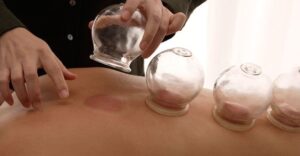
Cupping marks are a common sight on the backs and shoulders of Olympic athletes and Hollywood stars. This Traditional Chinese Medicine (TCM) therapy, dating back to 1550 BC, has gained popularity in the western world for its ability to ease pain and relax muscles. However, given the red and circular bruises that appear after the treatment, many people are intimidated and confused as to what cupping is and how it works. In this blog post, we will debunk the myths surrounding cupping and explain everything you need to know about cupping marks.
Cupping is a TCM treatment that uses glass cups or bamboo jars to create suction on the skin. This suction draws up the underlying tissues and muscles and increases blood flow. Cupping is often used to alleviate pain, inflammation, and stress, and is believed to balance the body’s energy, promote healing, and boost immunity.
The marks left behind by cupping are not bruises caused by trauma, nor are they permanent. The circular redness is due to the suction of the cups, which causes the blood vessels to expand and the blood to rush to the surface. The color and pattern of the marks vary depending on the individual’s skin tone, the intensity of the suction, and the length of the session. The marks usually fade within a few days to a week, but in some cases, they can last up to two weeks.
Contrary to popular belief, cupping is not painful. The sensation of the cups being suctioned onto the skin is unusual and may take some getting used to, but it should not be painful. If you experience discomfort during the session, you should tell your practitioner, and they will adjust the suction level accordingly. Cupping should not leave any marks, blisters or cuts on the skin. If you experience any of these symptoms, you might have received an incorrect treatment.
Cupping should not be administered over areas with varicose veins, broken skin, or sensitive areas such as the eyes. Pregnant women should also avoid cupping on the abdomen and lower back. Cupping is generally safe when performed by a licensed practitioner who has undergone proper training and follows safety guidelines.
Some people believe that cupping is an effective treatment for a wide range of ailments such as arthritis, asthma, and skin conditions. However, research on the effectiveness and safety of cupping is limited, and most studies have small sample sizes and lack proper controls. More large-scale, well-designed clinical trials are needed to evaluate the benefits and risks of cupping.
Cupping may seem like a mystical treatment, but it is rooted in science and tradition. Cupping marks are a natural and harmless outcome of the suction on the skin, and they should not deter you from trying this therapy. If you are interested in cupping, be sure to see a qualified practitioner who can guide you through the process and ensure your safety. While cupping may not be a magical cure-all, it may help alleviate pain, reduce stress, and improve your overall well-being.


Follow Us